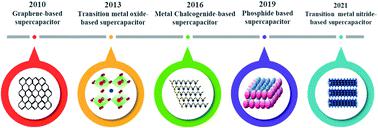当前位置:
X-MOL 学术
›
J. Mater. Chem. A
›
论文详情
Our official English website, www.x-mol.net, welcomes your
feedback! (Note: you will need to create a separate account there.)
Syntheses and electronic structure engineering of transition metal nitrides for supercapacitor applications
Journal of Materials Chemistry A ( IF 10.7 ) Pub Date : 2022-06-06 , DOI: 10.1039/d2ta02584a Shivraj Mahadik 1 , Subramani Surendran 2 , Joon Young Kim 2, 3 , Gnanaprakasam Janani 2 , Dong-Kyu Lee 2 , Tae-Hoon Kim 1 , Jung Kyu Kim 4 , Uk Sim 2, 3
Journal of Materials Chemistry A ( IF 10.7 ) Pub Date : 2022-06-06 , DOI: 10.1039/d2ta02584a Shivraj Mahadik 1 , Subramani Surendran 2 , Joon Young Kim 2, 3 , Gnanaprakasam Janani 2 , Dong-Kyu Lee 2 , Tae-Hoon Kim 1 , Jung Kyu Kim 4 , Uk Sim 2, 3
Affiliation

|
Supercapacitors are among the most promising energy storage devices; they exhibit a larger power density than batteries but a poor energy density. To meet the ever-increasing demands for energy, it is crucial to develop novel materials that improve the energy storage efficiency. Recent studies have focused on the use of different electrode materials in supercapacitors. Transition metal nitrides offer enormous potential in terms of energy storage because of their layered structure and high electrical conductivity, which promote promising properties in terms of stability, energy and power density, and lifetime. This review elaborates on the recent advances in transition metal nitrides. The different synthesis methods and different transition metal nitrides have been discussed and the electronic structure engineering strategies such as heteroatom-doped metal nitride, heterostructure metal nitride, and multi-metal nitride, have been focused on, which help improve the electrochemical performance of supercapacitors. Finally, the challenges, future direction, and perspectives of transition metal nitride for future direction have been discussed.
中文翻译:

用于超级电容器应用的过渡金属氮化物的合成和电子结构工程
超级电容器是最有前途的储能器件之一;它们表现出比电池更大的功率密度,但能量密度较差。为了满足不断增长的能源需求,开发能够提高储能效率的新型材料至关重要。最近的研究集中在超级电容器中使用不同的电极材料。过渡金属氮化物因其层状结构和高导电性而在储能方面提供了巨大的潜力,这在稳定性、能量和功率密度以及寿命方面具有良好的性能。本综述详细阐述了过渡金属氮化物的最新进展。讨论了不同的合成方法和不同的过渡金属氮化物,重点研究了杂原子掺杂金属氮化物、异质结构金属氮化物和多金属氮化物等有助于提高超级电容器电化学性能的电子结构工程策略。最后,讨论了过渡金属氮化物的挑战、未来方向和未来方向的前景。
更新日期:2022-06-06
中文翻译:

用于超级电容器应用的过渡金属氮化物的合成和电子结构工程
超级电容器是最有前途的储能器件之一;它们表现出比电池更大的功率密度,但能量密度较差。为了满足不断增长的能源需求,开发能够提高储能效率的新型材料至关重要。最近的研究集中在超级电容器中使用不同的电极材料。过渡金属氮化物因其层状结构和高导电性而在储能方面提供了巨大的潜力,这在稳定性、能量和功率密度以及寿命方面具有良好的性能。本综述详细阐述了过渡金属氮化物的最新进展。讨论了不同的合成方法和不同的过渡金属氮化物,重点研究了杂原子掺杂金属氮化物、异质结构金属氮化物和多金属氮化物等有助于提高超级电容器电化学性能的电子结构工程策略。最后,讨论了过渡金属氮化物的挑战、未来方向和未来方向的前景。











































 京公网安备 11010802027423号
京公网安备 11010802027423号